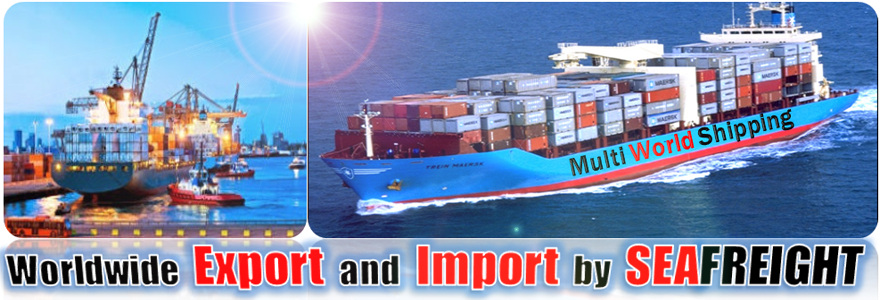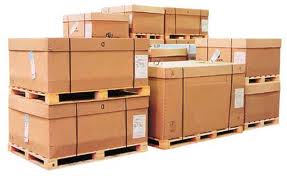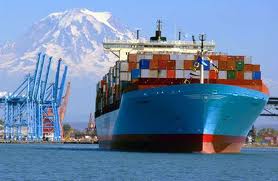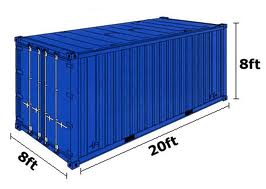How to Export Consignment to International Market
Why export to overseas markets ?
Exporting can improve growth and profit. It is a complex and demanding field.Which may not suit every company. Following are some of the basic important steps, which companies interested in export should consider.
Are you ready to export?
Developing
export markets can be costly in
terms of time,
money and
resources.
Does your company have the commitment required to make a success of
export? Entering new markets and developing them usually takes
considerable time and effort. You must take a long-term view. That time and cost can be multiplied several times when you
are looking at an overseas market.
Product
Know
your product and its
marketing advantages. What is unique about it?
What does it compete with? Price, whilst important, may not be the
deciding factor. You may need to change product design to suit different
markets. You will need to have good product literature available.
Consider whether your product or technology is more suited to a
licensing agreement. Ensure through
MITI,
Customs or a
freight forwarder
that your goods are not restricted for export or require a
permit and export license, this usually applies only to primary products.
Marketing
It
is useful to have a strong
marketing background. Does your company have
solid marketing knowledge and experience gained by selling in a number
of Overseas Market? To
success in
export markets is built on
a
solid domestic base.
Management
A
new export thrust will take considerable
management time. Does your
company have the production capacity to develop
export markets or can
the existing capacity be expanded if required?
Finance
Breaking
into new markets usually requires considerable funds (
air fares,
accommodation,
advertising,
sales promotion,
new brochures,
training of
overseas sales agents etc.). Does your company have the
financial
strength to commit significant funds for the year or two it may take to
develop a new overseas market? The amount of money required depends on
the nature and size of the
export company and of the complexity of the
markets they wish to enter. Markets such as the USA and Japan are
generally the most costly. It is possible however.
Export advice and assistance
It
is essential that you discuss your plans with experts from the
appropriate fields. Discuss costing for export with
your accountant and transport/packaging requirements with a customs
broker or forwarding agent.
Provides an extensive range of courses covering various
aspects of the exporting process such as getting started,
international
marketing, negotiations and trade documentation and payment methods.
Become familiar with the common terms used in international trade
(INCOTERMS)
Alternative approaches
You have the commitment, production capacity and financial resources but not the personnel. Consider using the services of:
- Export Merchants - who buy directly from you in local marketa and export the goods in their own right.
- Export
Agents - who, on a commission basis, arrange the export of your goods
complete all necessary paperwork and assist in sales promotion.
- Export
Consultants - who provide market research facilities and specialist
advice to exporters on matters such as export management, marketing
techniques, export incentives, pricing policies and other services
similar to export agents.
- Export Planning - Preparing a Company profile
If
you do not already have a
company profile, one should be prepared.
Overseas customers may require detailed information about your company
before they are willing to place an order. A
company profile is the most
professional way of presenting this information. A
company profile
should include: brief company history, recent achievements, a summary
page containing all the essential details (i.e. addresses, telephone,
fax, key personnel) and information on the product(s)/service(s)) you
offer (only a summary is necessary). You should include printed
literature if available.
Typically,
company profiles are between
three to 10 single sided pages. They should be easy to read and well
presented. Colloquialisms should be avoided at all costs.
Selecting a market
When
choosing a market, consideration should first be given to your product
or service. For instance, who is likely to purchase or use your product
or service? If you are producing computer software for the banking
industry you may wish to choose a country, which is known as a banking
centre like Singapore or Hong Kong.
If you are producing a luxury
well, you may want to target a developed country. Programs such as
Export Access can help first time exporters select a market.
It
is advisable that first time exporters concentrate on only one market to
start with, two at the most. Many new exporters start with markets
closer to home such as
New Zealand,
Papua New Guinea,
Fiji or
Singapore.
If you choose a larger market like the
US or Japan it is advisable to
select a region or city rather than the whole country to begin your
export program.
Market research
Once you have selected a country,
market research should be conducted. You should consider:
Size
of market (this will help gauge probable demand) Whether the country
selected already imports the product, and if so from where? Competitors
you encounter in the domestic market could well be the same as those you
encounter in the foreign market Import regulations, tariffs, embargoes,
quotas and other local charges
Other barriers to import such as import licensing
- Local taxes on the product
- Regulations such as quarantine, labelling, packaging requirements, consumer protection rules and products standards
- Geography (to help you determine major metropolitan area and port locations) Political and economic stability
- The social and business culture. Major accounting firms provide a range of country specific guides.
- The Department of Foreign Affairs and Trade, Chambers of
Commerce overseas and foreign Consulates and trade development offices
can assist in conducting market research.
As
an adjunct or alternative to market research it might be worth going on
a trade mission to a specific country or attending a trade show
pertaining to your product in that country. These activities will help
you gauge the business climate and
market opportunities in the targeted
country. It will also give you the opportunity to make preliminary
business contacts.
Finding an overseas customer
After
completing the
market research you should have a good indication of
your product/service potential in that market. Overseas customers must
now be found. As there are several ways to distribute your product
overseas, consideration should be given to the type of customer you
want. Will you sell your product through an agent, distributor or the
end user?An agent is usually appointed to handle a region, entire
country or group of countries. They normally carry no stock, but handle
the exporter's stock, which is forwarded to end users and dealers. As
the exporter's representative, the agent is paid on commission. It is
the agent's job to find and maintain the outlets in their territory.
They are involved with the
advertising and
promotional programs.
Further, they may be needed to prepare documentation for importers where
complicated import licences are required by the government.
- Distributors
buy product directly from the exporter for their own inventory and are
responsible for the sale and, in many cases, after-sales service.
- Guidelines
for drawing up commercial agency and distributorship agreements. Seek legal advice before entering into commercial
partnerships.
- Other direct selling options include: to the end
user, retail chain stores; government organizations or to users via mail
order advertising.
Obviously your method of distribution
will depend on your product and how it is distributed in
local Market. If
your product requires assembly or after sales service, a distributor may
be the best method. If you produce large, capital equipment, selling to
the end user may be more appropriate. The same organization, which can
assist you with overseas market research, can help you locate foreign
contacts.
Making a connection
Potential
customers should be contacted by letter or fax. If the customer is an
agent or distributor, who handles a number of clients other than
yourselves, you should ensure that the information you provide is not
going to be used purely as market research for your competitors.
The
initial contact should include a brief letter, a description of your
product(s)/service(s)) and/or a brochure. It is not necessary to send a
company profile or price list at this initial stage.
Interested
parties will come back to you for this information. At this point you
should think about planning a market visit. This is an essential part of
every export program. Not only will it give you the opportunity to meet
face to face with potential agents and/or distributors, but it will
also allow you to see first hand the market opportunities, to
investigate local pricing, observe the competition and get a feel for
how business is conducted in a new environment.
Being aware of
cultural sensitivities, customs and business practices can help in the
marketing, sales and the negotiation process. Further, it will provide
you with the
opportunity to make more contacts in the market.
Preparing a quotation
It
is important to be as specific and accurate as possible when preparing a
quotation for an overseas customer. Elements to be included in your
export quotation are: Product description and specifications, including
part and model numbers; quantity; unit price basis; payment terms; point
of embarkation and destination; shipment method (air or ocean): packing
details (if available); documentation provided and delivery. It must
also be made clear in what currency you are quoting. Your research
should indicate what the market price for your product is. Remember, it
is always easier to lower prices than it is to raise them.
A
quotation can be prepared on a letterhead, fax form or as a proforma
invoice (formal export quotation), which is often required by the
customer to obtain an import licence. To avoid any confusion the prices
should be always quoted on the basis of a stated
Incoterm. These trade
terms are used to specify the division of obligations, costs and risks
between the buyer and seller during shipment of the goods, and are
accepted worldwide. To ensure that the prices are clear, along with the
abbreviated Incoterm, reference should be also made to a named place,
port of shipment or port of destination (FOB, CNF, CIF) Incoterms . If you are arranging for
shipment of the goods, a
freight forwarder can recommend the best and
most economical method of shipment, as well as provide a quotation for
all transportation costs including documentation. The nature, size and
weight of your product will determine if it will be shipped by sea or
air. If you do not have your own insurance, the
freight forwarder can
arrange it. If special packing is required for export, make sure the
cost is included in your quotation. The customer, on the other hand, may
prefer to arrange the shipment him or herself. If this is the case, you
may only have to provide prices ex-works or delivered to a specified
warehouse or port (
FOB).
Another important element in your quotation is the terms of payment.
After
all, you want to make sure the overseas buyer will pay you. The most
common methods of payment are:Open account, prepayment, documentary
collections, and
documentary letter of credit. If the overseas customer
insists on open account terms, you will want to run a full credit check.
Further,
organizations like the Export Finance and Insurance Corporation (EFIC)
can help you manage your credit risks by insuring your receivables.
Factoring companies can also help manage your trade debt.
Receiving and processing an order
When
an order is received, it should be checked thoroughly to make sure it
is acceptable to you. The order should be checked and acknowledged and
any changes required, including payment terms, notified to the customer.
Once you have accepted the order there is little you can do to change
it. Further, if payment is by
documentary letter of credit, this should
be checked to ensure that you could comply with its terms and
conditions. If you cannot, you need to ask your customer to amend the
letter of credit. After you have checked the order to your satisfaction,
an order "acknowledgment" should be sent to your customer. This will
advise them that the order has been received and is being produced.
Further, you should retain the terms of sale.
As the order is
processing, you should keep your customer and
freight forwarder
appraised of delivery so they can plan and schedule its shipment. Once
the order has been shipped you should inform your customer of all
shipping details.
Certain documents must accompany your shipment
to allow the importer to clear the goods through customs at the country
of destination. Your
freight forwarder can advise you of these. Specific
documents may also be requested from your customer or will be specified
in the
documentary letter of credit. Among the most common documents
are:
- Commercial Invoice - often these must be prepared in accordance
with the buyer's instruction, for example they include details of the
number of packages, weight(s) and volume of the goods being shipped.
Invoices should be manually signed and dated:
- Bill of
landing (B/L) - is a legal document under which cargo is accepted for
carriage on board a vessel. It acts as a receipt for goods and confers
ownership of the goods.
Your
freight forwarder can take care of
all export arrangements with the
Customs Service. Depending
on the method of shipment and payment, original documents must be sent
to the customer with the shipment, by air, registered or express mail or
through the banks.
Question how should I, label my goods?
Answer:
The
labelling of cargo is often overlooked, when preparing the
shipment. The labelling process identifies your cargo from other
shipper's cargo as being uniquely yours. It also
supplies important
consignment information to the cargo Handlers.
The labels should
clearly state your Consignment address with phone number, fax numbers
and contact person, the labels should then be securely attached to each
cargo piece.
Your cargo labels should be numbered 1 up.
For
example, you have 10 cargo pieces, then each piece should be marked 1 of
10, 2 of 10, 3 of 10 ECT, ECT. This numbering method identifies to each
person involved in the cargo transport chain that there are 10 cartons
belonging to this shipment.
When shipping with our service, we
take every care of your cargo, however should any cargo be misplaced
during the shipment handling process and you have followed the correct
labelling procedure it will greatly increase the correct cargo handling
process thus ensuring a smoother cargo delivery.
p/s :
Should you require specialised container equipment,
Freight Rates for Export Shipment (FCL/LCL) or if you
have any further questions please
contact us click Here.































